|
58. Plebejus optilete (Knoch, 1781) / Cranberry blue / Lycaenidae – Polyommatinae
NL: veenbesblauwtje / D: Hochmoor-Bläuling / F: l’argus pervenche, l’azuré de la cannberge
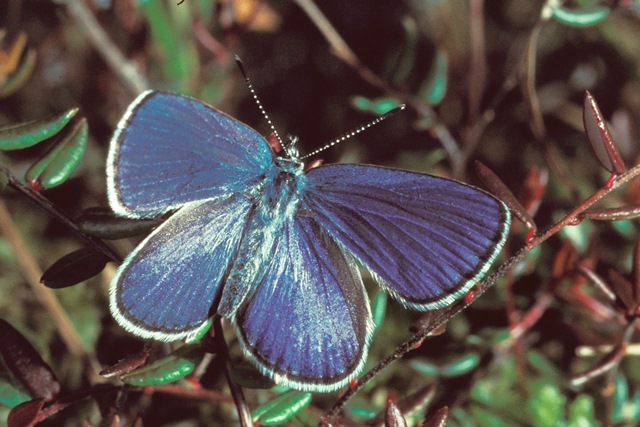 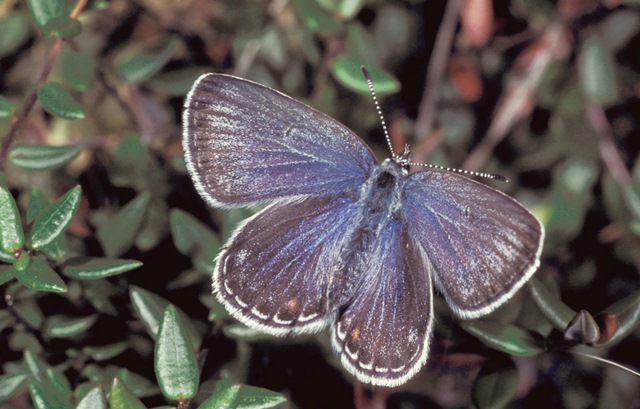 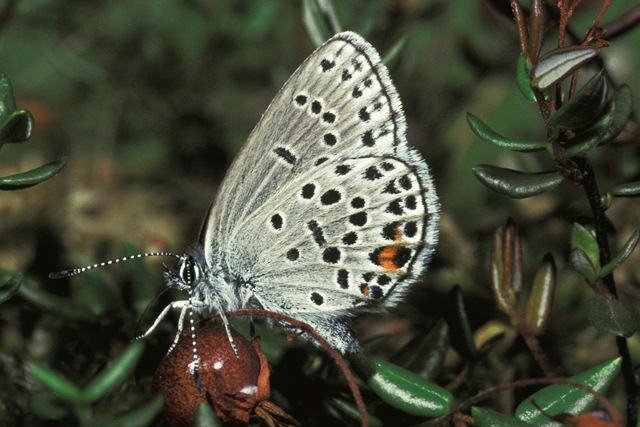
Photographs: Frits Bink ©.
Small, wing length 14 (13-15) mm. In the Benelux, it occurs only in a few places in Drenthe, Netherlands, on raised bogs; previously it was present in several places in the eastern part of the country and in an oak wood with an underbrush of Vaccinium vitis-idaea.
The butterflies are on the wing from mid-June until early-July, peak end June. The species is known from sub-continental to severe continental climates, amplitude 7 to 20, from sub-arctic to alpine and from mountainous regions. Required heat sum 150°d. Maximum tolerated 800°d, corresponding climate windows 14 and 25 weeks.
The colony that had existed in the bog Wooldsche Veen, near Winterswijk disappeared there about 1988, following destruction of the habitat by rigorous management.
The species is considered to be a relic of glacial periods that survives in the Netherlands in the coolest places but astonishing it does not occur in the Ardennes where plenty of suitable sites are present.
Ecological characteristics
Behaviour over time
Overwintering: small larva, third instar, 3 mm in length and reddish in colour, hidden in the litter layer.
Reproduction: oviposition starts after 3-4 days when the body contains about 74 eggs, estimated potential number 1.4 times as much.
Larval feeding periods: in summer 6-7 weeks in period early-July until early-September, in spring 4-5 weeks from end-April until early-June.
Generations: one.
Spreading of risk: not observed.
Life cycle: egg about 9 days, larva in summer 48 (43-53) days, after hibernation in spring 32 (24-38) days; pupa about 18 days.
Life span of adult: short, 2 weeks.
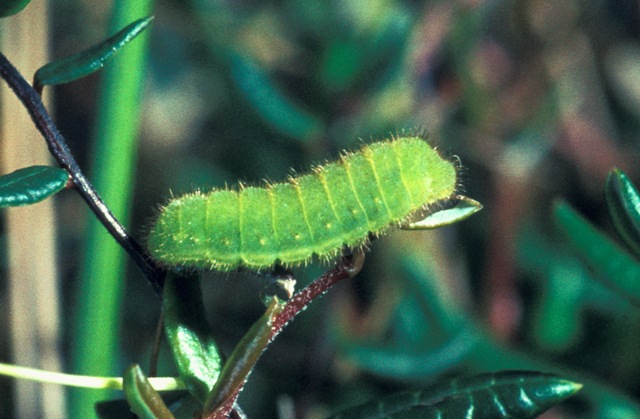 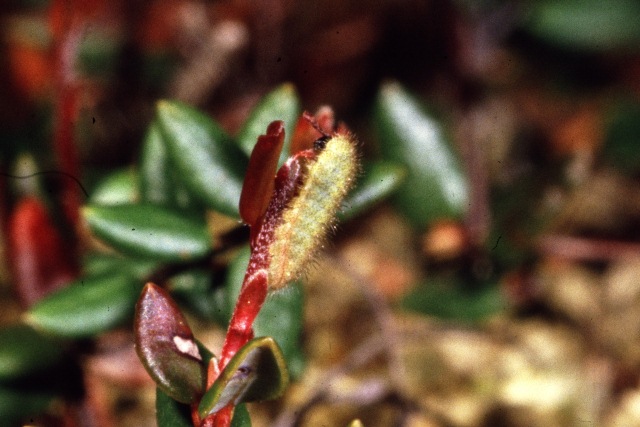
Photographs: Frits Bink ©.
Behaviour in space
From stay-at-home to migrant: stay-at-home, spatial requirement modest.
Finding a mate: male perches most of the time.
Orientation in the landscape: short shrub vegetation in humid places, on bogs and open woods.
Oviposition: eggs laid singly on the underside of mature leaves.
Defence
Threats from other organisms: avoiding risk by predators by a life style of hiding and fast development.
Myrmecophily: no trace of organs and no attention by ants observed.
Threats from the environment: butterflies are very sensitive to heat and drought.
Feeding habits
Adult: nectar of small flowers like cross-leaved heath.
Larva: young larva mines old leaf or eats furrows into it, after hibernating it feeds on the shoots and flowers.
Larval foodplants
Plant species: Ericaceae, Andromeda polifolia, Vaccinium oxycoccus, V. vitis-idaea.
Journal
Rearing experiment based on specimen from Langeveen, Dwingeloo, Netherlands:
3 July 1985: two females captured, many males were present at the locality.
5 July: butterflies dead, 20 eggs laid on Andromeda polyfolia and Vaccinium oxycoccus.
14 July: eggs hatched.
23 July: larvae first instar.
27 July: seven larvae seen in first instar.
2 August: first larva in L2.
26 August: three larvae in L3, others were probably already in diapause in moss layer.
6 September: on Andromeda three larvae were active, others in diapause.
Overwintered outdoors.
20 April 1986: V. oxycoccus showed first signs of sprouting.
5 May: first third instar larvae was seen, green in colour.
13 May: larvae in moult, preferred the sunny side of the host plant.
20 May: larvae fully grown.
26 May: first prepupa.
29 May: pupated.
15 June: adult butterfly appeared, male.
Table 58-1. Results of dissections

Table 58-2. Collection and observation localities
DK, Tofte Mose 56° 49’ 16”N – 10° 16’ 08”E; 4 July 2005.
DK, Tofte Mose 56° 50’ 39”N – 10° 11’ 11”E; 5 July 2005.
EST, Valge raba 58° 26’ 29”N – 25° 14’ 09”E; 8 July 1999.
NL, Dwingelo o, Lange Veen 52° 48’ 58”N – 6° 25’ 44”E; 3 July 1985.
NL, Dwingeloo, Meeuwenplas 52° 50’ 05”N – 6° 27’ 34”E; 25 July 1980, 3 July 1985.
S, Gotland, Ljugarn 57° 22’ 03”N – 18° 41’ 31”E; 15 July 1982.
Fig. 58-1. Plebejus optilete, phenogram adapted from Bos et al. 2006: 195.
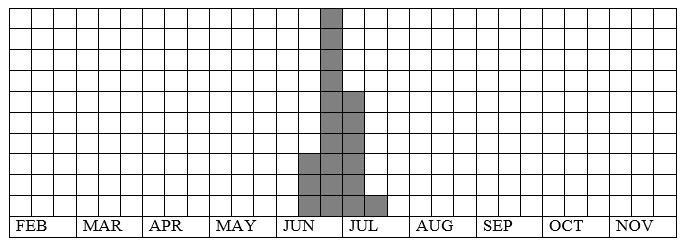
Fig. 58-2. Plebejus optilete, habitat characteristics.
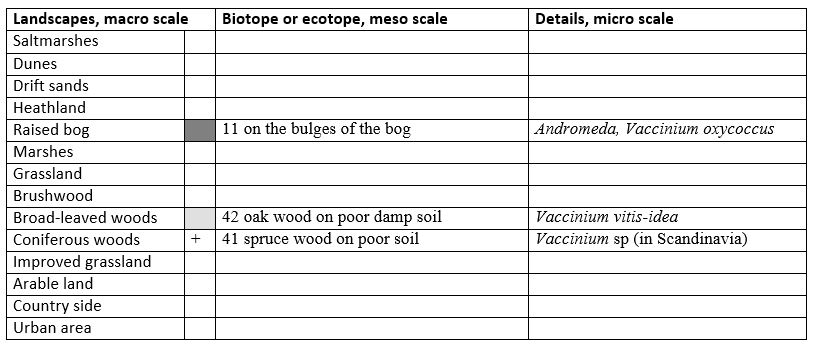
Fig. 58-3. Plebejus optilete, climate matrix, heat-sums 150 - 800°d.
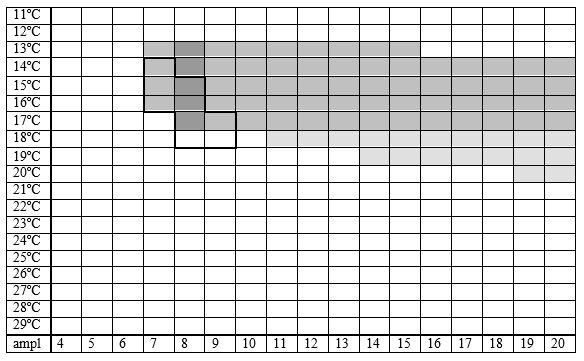
|










